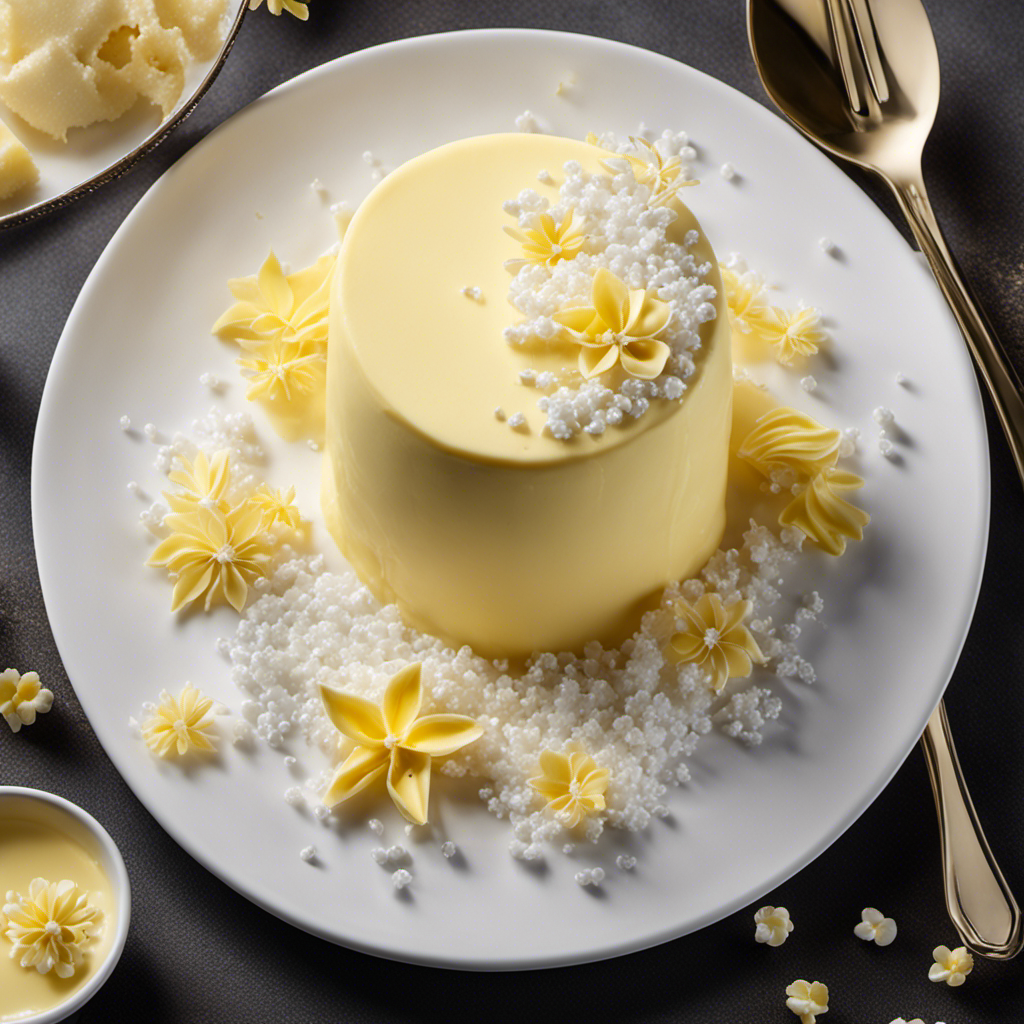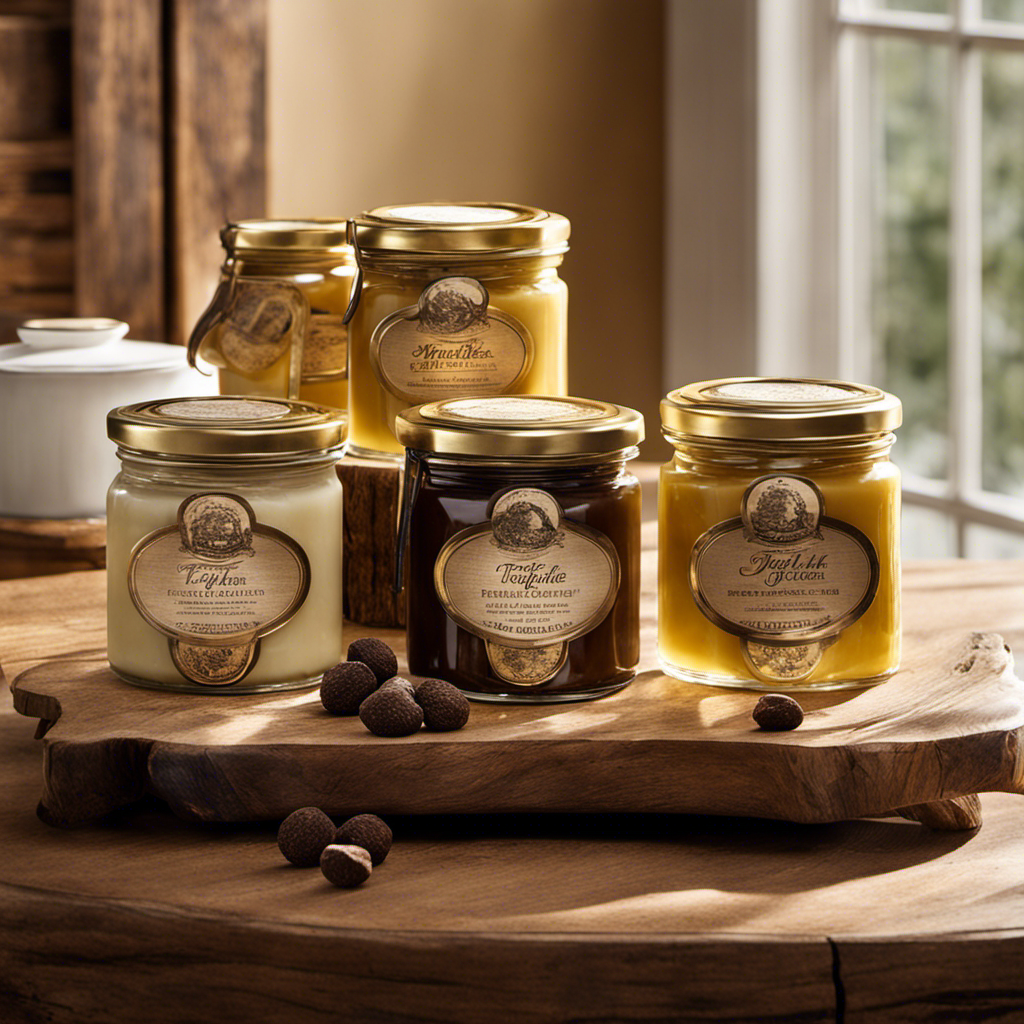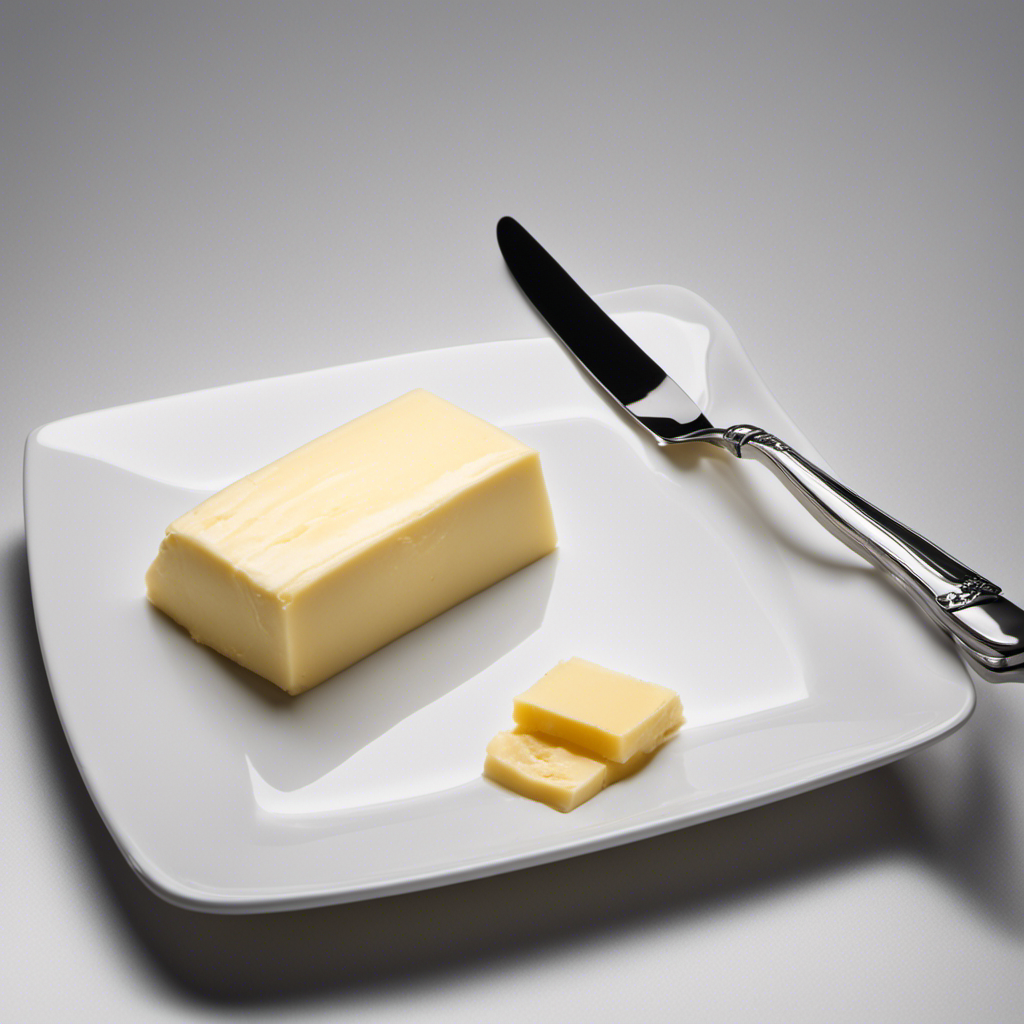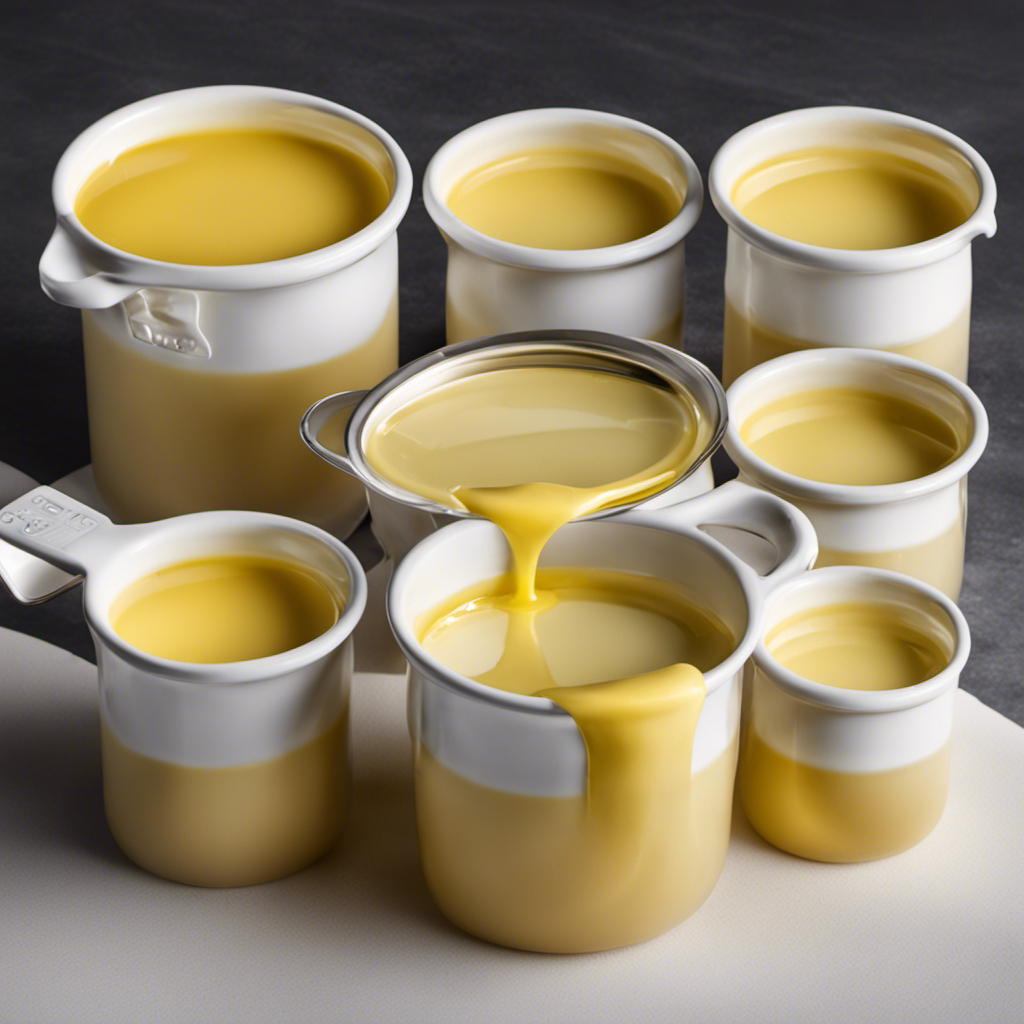Were you aware that butter, a fundamental component often used in various recipes, might have an unexpectedly high sodium content? Indeed, the amount of sodium in various butter varieties can differ greatly.
As someone who is conscious of their sodium intake, I was curious to explore just how much sodium is in butter and its potential health risks.
In this article, we will delve into the sodium content of various butter brands, alternative low-sodium options, and the importance of monitoring our daily sodium intake.
Key Takeaways
- Salted butter contains a significant amount of sodium, with approximately 82 milligrams per tablespoon.
- Regular consumption of salted butter can contribute to high sodium intake, which is linked to increased risk of high blood pressure and heart disease.
- Opting for unsalted butter or lower-sodium alternatives, such as olive oil, coconut oil, avocado, or Greek yogurt, is recommended for heart health and reducing sodium intake.
- Reading nutritional labels and choosing low-sodium products, cooking meals from scratch, and limiting processed foods are strategies to reduce sodium intake and improve overall health.
Sodium Content in Salted Butter
You might be surprised by how much sodium there is in salted butter. Many people assume that butter is a relatively low-sodium option, but the truth is that it can actually contain a significant amount of sodium.
According to the United States Department of Agriculture (USDA), one tablespoon of salted butter contains approximately 82 milligrams of sodium. This sodium content may not seem high compared to other foods, but it can add up quickly if you consume butter regularly.
High sodium intake has been linked to various health issues, including an increased risk of high blood pressure and heart disease. Therefore, it is important to be mindful of the sodium content in margarine and other butter substitutes as well, as they may also contain significant amounts of sodium.
Opting for unsalted butter or lower-sodium alternatives can be a healthier choice for your heart health.
Sodium Content in Unsalted Butter
When it comes to butter, one key consideration is its sodium content. While salted butter is known to have a higher sodium content, it’s important to explore the options available for those who want to reduce their sodium intake.
In this discussion, we’ll delve into the sodium content of unsalted butter and explore the alternatives for those seeking a lower sodium option.
Sodium in Butter
There’s a significant amount of sodium in butter, so if you’re watching your sodium intake, it’s important to be aware of the sodium content in different types of butter. Here are some key points to consider:
-
Sodium in Margarine: Margarine, a butter substitute made from vegetable oils, can vary in sodium content. Some brands may contain high levels of sodium, while others offer low-sodium options.
-
Sodium in Plant-Based Butter Alternatives: Plant-based butter alternatives, like those made from coconut or avocado oil, can be a healthier option for those looking to reduce their sodium intake. However, it’s essential to check the label as the sodium content can vary among different brands.
-
Reading Nutritional Labels: Always read the nutritional labels to determine the sodium content in butter and its alternatives. Look for products labeled as low-sodium or unsalted to minimize your sodium intake.
Considering these factors, it’s worth exploring unsalted butter options that can provide a lower sodium alternative for those who need to limit their sodium intake.
Unsalted Butter Options
Unsalted butter options offer a lower sodium alternative for those who need to limit their intake. When it comes to reducing sodium in butter recipes, using unsalted butter is a great choice. Here are some low sodium butter substitutes that you can consider:
| Butter Substitute | Sodium Content (per 1 tablespoon) |
|---|---|
| Unsalted Butter | 0mg |
| Olive Oil | 0mg |
| Coconut Oil | 0mg |
| Avocado | 0mg |
| Greek Yogurt | 0mg |
These alternatives not only provide a delicious taste, but they also help in reducing the sodium content in your dishes. Whether you are baking or cooking, replacing regular butter with these options can make a significant difference in your sodium intake. So next time you’re in the kitchen, consider using one of these low sodium butter substitutes to make your recipes healthier and more flavorful.
Recommended Daily Sodium Intake
When it comes to sodium intake, it’s important to follow the guidelines set by health organizations. Consuming too much sodium can pose serious health risks, such as high blood pressure and an increased risk of heart disease.
To reduce sodium intake, there are various strategies that can be implemented. One strategy is reading food labels to check the sodium content of packaged foods. This can help individuals make more informed choices and opt for lower sodium options.
Another strategy is cooking at home. By preparing meals from scratch, individuals have more control over the amount of sodium that goes into their dishes. They can use herbs, spices, and other flavorings to enhance the taste of the food without relying on excessive salt.
Choosing lower sodium alternatives is also an effective way to reduce sodium intake. This can include opting for fresh fruits and vegetables instead of processed snacks, or choosing low sodium versions of condiments and sauces.
Sodium Intake Guidelines
You should follow the sodium intake guidelines to manage your overall sodium consumption. Here are some important points to consider:
-
Recommended Daily Sodium Intake: The American Heart Association recommends limiting sodium intake to less than 2,300 milligrams (mg) per day, and ideally to 1,500 mg per day for most adults.
-
Sodium Reduction Strategies: To reduce your sodium intake, try these strategies:
- Read food labels and choose low-sodium or sodium-free products.
- Cook meals at home using fresh ingredients to control the amount of sodium.
- Limit processed and packaged foods, as they tend to be high in sodium.
- Use herbs, spices, and other flavorings to enhance the taste of your food instead of relying on salt.
Health Risks of Excess Sodium
Excess sodium intake can lead to various health risks, such as high blood pressure and an increased risk of heart disease. Consuming too much sodium can have a detrimental impact on our blood pressure levels.
When we consume high levels of sodium, our body retains more water to maintain balance, leading to increased blood volume and higher blood pressure. This puts strain on our cardiovascular system and can ultimately increase the risk of heart disease.
However, reducing sodium intake can have significant health benefits. Studies show that decreasing sodium intake can lower blood pressure, reducing the risk of heart disease and stroke. Additionally, reducing sodium intake can improve kidney function, decrease fluid retention, and even help with weight loss.
Taking small steps to reduce sodium in our diets can have a big impact on our overall health.
Sodium Reduction Strategies
Reducing sodium intake is crucial for maintaining a healthy blood pressure level. Excess sodium in our diet has been linked to hypertension, a major risk factor for heart disease and stroke.
To combat this, there are several techniques that can help reduce our sodium consumption:
-
Read food labels: Pay attention to the sodium content of packaged foods and choose low-sodium options whenever possible.
-
Cook from scratch: When we prepare our meals at home, we have control over the amount of sodium added. Using fresh ingredients and herbs and spices for flavoring instead of salt can significantly lower sodium intake.
-
Limit processed foods: Processed foods are typically high in sodium. Opt for whole, unprocessed foods such as fruits, vegetables, and lean proteins.
-
Be mindful of condiments: Sauces, dressings, and condiments can contain a surprising amount of sodium. Choose low-sodium or homemade alternatives.
Health Risks of Consuming Too Much Sodium
There is a link between consuming excessive sodium and potential health risks. Consuming too much sodium can lead to several negative health implications, including high blood pressure, increased risk of heart disease, and stroke.
It is important to be aware of the sodium content in our diets and take steps to reduce our sodium intake. Sodium reduction strategies can include reading food labels carefully, choosing low-sodium options, cooking meals from scratch using fresh ingredients, and limiting the use of processed and packaged foods.
Comparison of Sodium Levels in Different Butter Brands
When it comes to butter, there can be significant variations in sodium content among different brands. This is important to consider because consuming excessive sodium can have negative health implications, such as increased risk of high blood pressure and heart disease.
Sodium Content Variations
To easily determine the sodium content variations in butter, you can check the nutrition labels on different brands. Here’s what you need to know about the sodium content in butter and its impact on heart health:
-
Sodium content in margarine alternatives: Margarine is often used as a butter substitute, but it can have higher sodium levels. Some margarine brands may contain up to 400 milligrams of sodium per serving.
-
Impact of sodium on heart health: Consuming too much sodium can lead to high blood pressure, which increases the risk of heart disease and stroke. The American Heart Association recommends limiting sodium intake to no more than 2,300 milligrams per day.
-
Checking nutrition labels: When comparing butter brands, look for those labeled ‘low sodium’ or ‘unsalted.’ These options typically have less sodium per serving.
-
Moderation is key: While butter can be enjoyed in moderation, it’s important to be mindful of your overall sodium intake and choose lower sodium options whenever possible.
Health Implications of Sodium
Consuming excessive amounts of sodium can lead to high blood pressure, increasing the risk of heart disease and stroke. It’s important to be mindful of our sodium intake for the sake of our heart health.
High sodium levels can cause the body to retain water, putting extra strain on the heart and blood vessels. Additionally, excessive sodium intake can negatively affect kidney function. The kidneys play a crucial role in regulating sodium levels in the body.
When sodium levels are too high, the kidneys have to work harder to eliminate the excess sodium, which can lead to kidney damage over time. Therefore, it is essential to monitor our sodium intake to maintain optimal heart health and support proper kidney function.
Sodium in Homemade Butter Vs. Store-Bought Butter
If you make your own butter at home, you’ll likely have more control over the sodium content compared to store-bought butter. Here are some key factors to consider when it comes to sodium content in different types of butter:
-
Sodium content in vegan butter: Vegan butter is typically made from plant-based oils, and many brands offer low-sodium options. However, it’s important to check the label as some vegan butters can still contain a significant amount of sodium.
-
Sodium content in whipped butter: Whipped butter is often lower in sodium compared to regular butter. The whipping process incorporates air, making the butter lighter and reducing its overall sodium content.
-
Homemade butter: When making your own butter at home, you have complete control over the sodium content. By starting with unsalted cream, you can avoid adding any sodium to your homemade butter.
-
Store-bought butter: Store-bought butter usually contains salt to enhance flavor and increase shelf life. This can significantly increase the sodium content.
Sodium Content in Salted Vs. Unsalted Cultured Butter
When choosing between salted and unsalted cultured butter, you’ll experience a difference in taste due to the varying levels of seasoning. Salted cultured butter, as the name suggests, contains added salt during the churning process. This salt enhances the flavor profile and can give a slightly savory taste to dishes.
On the other hand, unsalted cultured butter lacks this added sodium, allowing the natural flavors of the butter to shine through. It is important to consider the sodium content when choosing butter or margarine alternatives. While butter typically contains low levels of sodium, margarine alternatives can vary greatly in their sodium content.
Additionally, for those following a vegan diet, it’s worth noting that some vegan butter substitutes may also contain higher sodium levels. Therefore, it’s always a good idea to read the labels and choose the option that aligns with your dietary needs.
Low-Sodium Butter Alternatives
Opting for low-sodium alternatives can be a healthier choice for individuals looking to reduce their salt intake. When it comes to butter, there are several options available that offer a lower sodium content. Here are four low-sodium butter alternatives to consider:
-
Unsalted Butter: This is a common option for those seeking to minimize their sodium intake. Unsalted butter contains no added salt, allowing you to control the amount of sodium in your dishes.
-
Ghee: Ghee is clarified butter that has been simmered to remove water and milk solids. It has a rich, nutty flavor and a lower sodium content compared to regular butter.
-
Olive Oil Spread: Made from a blend of olive oil and other vegetable oils, this spread offers a lower sodium alternative to traditional butter. It provides a creamy texture and a hint of olive oil flavor.
-
Vegan Butter: Vegan butter substitutes, such as those made from coconut oil or avocado oil, are often low in sodium. They can be a great option for those following a plant-based diet or looking to reduce their sodium intake.
Sodium Content in Flavored Butters
In my quest to find low-sodium butter alternatives, I stumbled upon a variety of flavored butter options. These compound butters are made by blending butter with various herbs, spices, and other ingredients to create a burst of flavor. However, I was curious about the sodium content in these flavored butters.
To provide you with an overview, I have compiled a table showcasing the sodium content in five popular flavored butters:
| Flavored Butter | Sodium Content (per 1 tbsp) |
|---|---|
| Garlic Butter | 90mg |
| Herb Butter | 85mg |
| Honey Butter | 70mg |
| Lemon Butter | 75mg |
| Cinnamon Butter | 60mg |
While these flavored butters do contain some sodium, the amounts are relatively low compared to regular salted butter. However, it’s important to note that portion sizes can vary, so be mindful of your overall sodium intake when enjoying these flavorful spreads.
Sodium Content in Clarified Butter
While clarified butter is a popular alternative, it’s important to be aware of its sodium content. Contrary to popular belief, clarified butter, also known as ghee, does contain some sodium. Here’s a breakdown of the sodium content in ghee and margarine:
-
Sodium in ghee: On average, one tablespoon of ghee contains about 1-2 milligrams of sodium. This is a relatively low amount compared to other butter alternatives.
-
Sodium in margarine: Margarine, on the other hand, can vary in sodium content depending on the brand and type. Some margarines can contain up to 100 milligrams of sodium per tablespoon, especially those with added flavorings or salt.
-
Sodium considerations: If you’re watching your sodium intake, it’s important to check the labels of both ghee and margarine to find options with lower sodium content. Opting for unsalted versions or those labeled as low-sodium can help reduce your sodium intake.
-
Moderation is key: Regardless of the sodium content, it’s always important to consume any type of butter in moderation as part of a balanced diet.
Sodium Content in Grass-Fed Butter
If you’re looking for a lower sodium option, grass-fed butter may be a good choice for you. Grass-fed butter has several benefits compared to regular butter. Firstly, it is made from cows that are raised on a natural grass diet, which results in a higher concentration of heart-healthy omega-3 fatty acids. These fatty acids have been shown to reduce inflammation and improve overall cardiovascular health.
Additionally, grass-fed butter is higher in vitamins A, E, and K2, which are important for maintaining healthy skin, eyes, and bones.
When it comes to sodium content, grass-fed butter generally has a lower amount compared to regular butter. This is beneficial because high sodium intake has been linked to increased blood pressure, which is a risk factor for heart disease.
Frequently Asked Questions
Can I Consume Butter if I Have a Low-Sodium Diet?
I can consume butter if I have a low-sodium diet. There are low sodium butter options available that can help in managing sodium intake. It’s important to be mindful of the impact of butter on overall sodium intake.
What Are the Health Risks of Consuming Too Much Sodium?
Consuming too much sodium can lead to health risks such as high blood pressure, heart disease, and stroke. It is important to stay within the recommended daily intake for sodium to maintain good health.
Are There Any Low-Sodium Alternatives to Regular Butter?
There are low-sodium spreads available as alternatives to regular butter. These spreads contain less sodium and can be a healthier option. They provide a similar taste and texture for those looking to reduce their sodium intake.
Does the Sodium Content in Butter Differ Between Homemade and Store-Bought Varieties?
When comparing homemade butter to store-bought varieties, the sodium content can vary. It’s important to read the labels and choose low-sodium options if that’s a concern for you.
Is There a Significant Difference in Sodium Levels Between Salted and Unsalted Cultured Butter?
There is a significant difference in sodium levels between salted and unsalted cultured butter. The sodium content in salted butter is higher due to the addition of salt, while unsalted butter has a lower sodium content.
Conclusion
In conclusion, it’s important to be mindful of the sodium content in butter. Excessive sodium intake can pose potential health risks. By choosing low-sodium butter alternatives or opting for unsalted butter, we can reduce our sodium intake. We can still enjoy the rich and creamy taste of butter while prioritizing our health. It’s crucial to make informed choices about the foods we consume. Let’s take control of our sodium intake and savor the goodness of butter without compromising our well-being.










